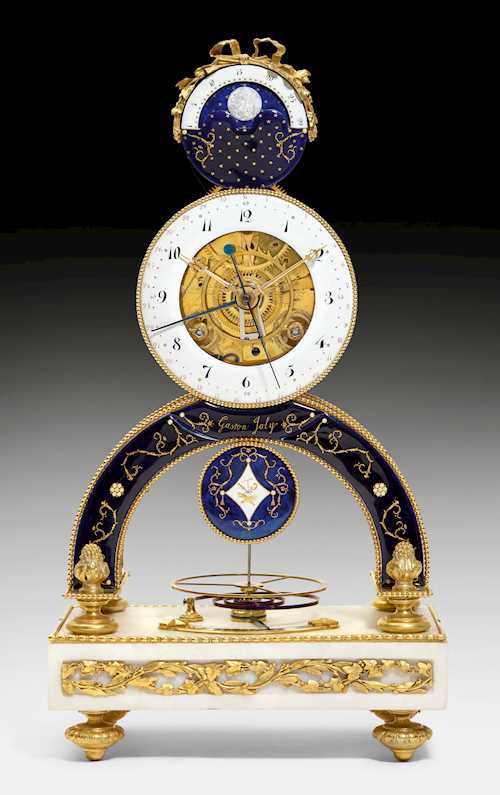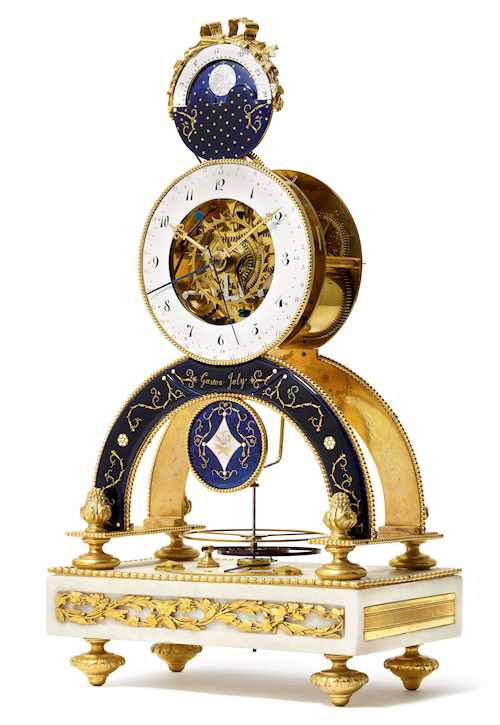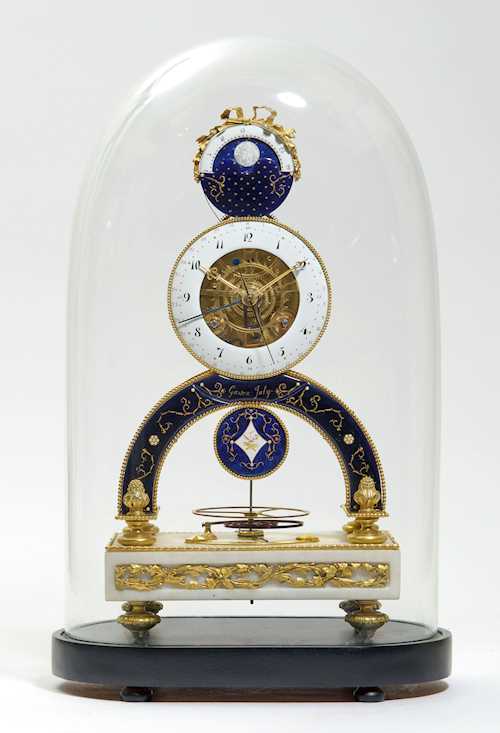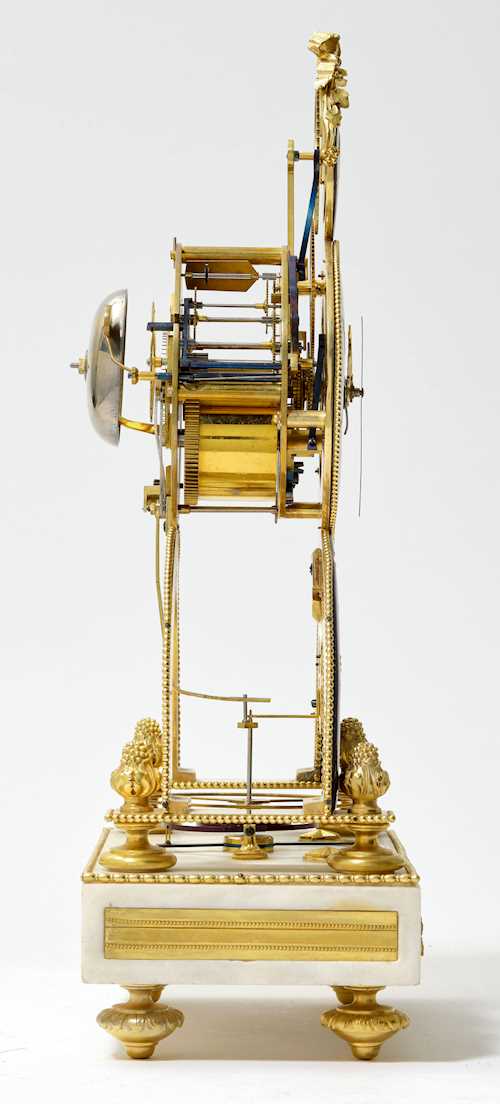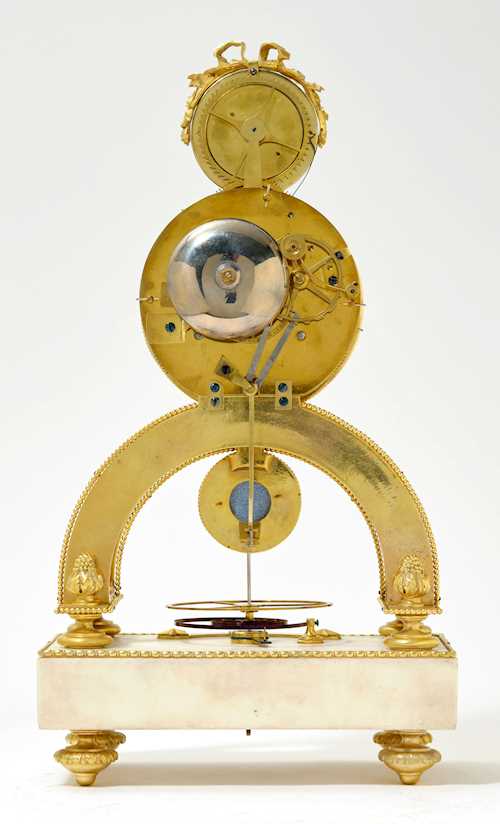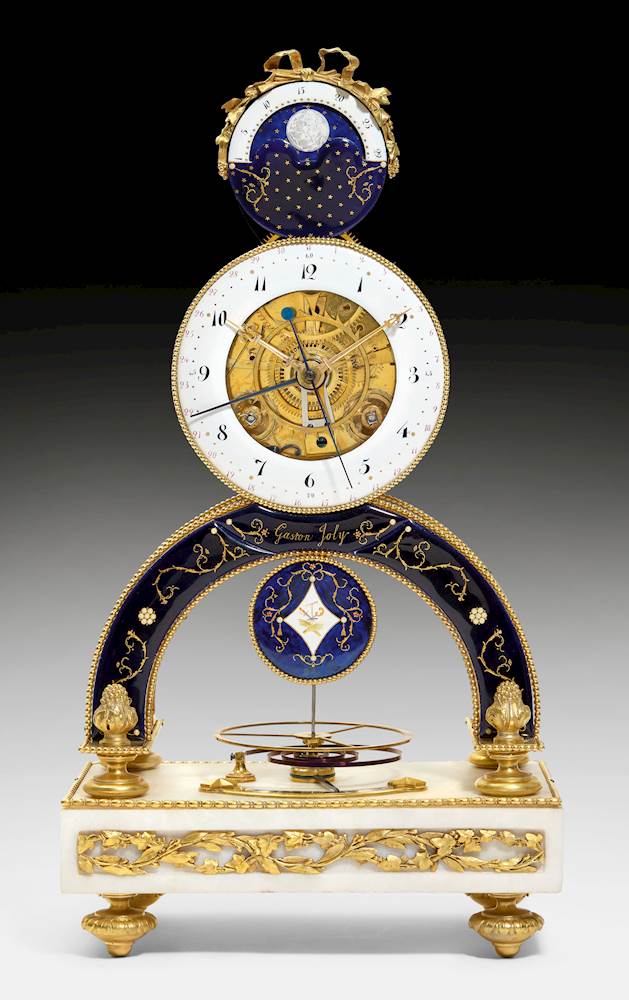
Lotto 1191* - A210 Arti decorative - giovedì, 19. settembre 2024, 14h00
ENAMELED SKELETON CLOCK WITH SECONDS, MOON PHASE AND DATE
Paris, ca. 1790, signed Gaston Joly (François-Pierre dit Gaston Jolly, maître 1784 in Paris).
Brass and gilt bronze. The cobalt blue enamel, painted with leaf garlands, flowers and star motifs, probably by Coteau or Dubuisson. White enamel chapter ring with Arabic numerals for the hours, the seconds and date in black and red, respectively. Visible, partially open movement. Mounted on an arched base on flattened feet, decorated with a pomegranate. On a white marble plinth and round feet decorated with a leaf frieze. The front of the base has a recess with an applied laurel garland in gilt bronze. Above the movement, a small enamel dial with a semi-circular aperture to indicate the moon phase. Movement with half-hour strike on bell. Spiral pendulum. With a black base and glass dome. 1 key.
23 × 13 × 41 cm; H with base and dome 52 cm.
In good restored condition. Movement needs to be checked. Slight corrosion to the mounting of the bow.
Provenance:
German private collection.
Skeleton pendulum clocks emphasize the technical aspect of a clock, the fine mechanism and the sophisticated gear train by freeing them from the closed case and displaying them as open as possible. Whereas the case of earlier clocks had an almost sculptural character, in which the movement was concealed, the skeleton clock has a relatively simple frame that supports the movement. Many such skeleton clocks were completely devoid of decorative elements, while others, such as the one on offer here, were adorned with decorative enamel work. This type of decoration lent the pendulum visual elegance and finesse without detracting too much from the original idea of presenting the technical aspect.
The most famous and finest enamel plaques were produced by Joseph Coteau (1740-1801) and Etienne Gobin, known as Dubuisson (1731-1815). The decoration and quality of the enamel work on the clock on offer here also suggest work by Coteau or Dubuisson.
Another special feature of the clock on offer is the spiral pendulum, in which the amplitude of the pendulum is translated into a rotary movement. This ingenious pendulum shape further emphasizes the technical aspect. (Some comparable skeleton pendulum clocks are mentioned in: Pierre Kjellberg: Encyclopédie de la pendule française du Moyen age au XXe siècle. Paris 197, pp. 315-324, especially fig. G).
Few clocks by the clockmaker Gaston Jolly, actually François-Pierre Jolly, have survived. A comparable watch was offered at Pierre Berger & Associés, June 10, 2009, lot 296.
Provenance:
German private collection.
Skeleton pendulum clocks emphasize the technical aspect of a clock, the fine mechanism and the sophisticated gear train by freeing them from the closed case and displaying them as open as possible. Whereas the case of earlier clocks had an almost sculptural character, in which the movement was concealed, the skeleton clock has a relatively simple frame that supports the movement. Many such skeleton clocks were completely devoid of decorative elements, while others, such as the one on offer here, were adorned with decorative enamel work. This type of decoration lent the pendulum visual elegance and finesse without detracting too much from the original idea of presenting the technical aspect.
The most famous and finest enamel plaques were produced by Joseph Coteau (1740-1801) and Etienne Gobin, known as Dubuisson (1731-1815). The decoration and quality of the enamel work on the clock on offer here also suggest work by Coteau or Dubuisson.
Another special feature of the clock on offer is the spiral pendulum, in which the amplitude of the pendulum is translated into a rotary movement. This ingenious pendulum shape further emphasizes the technical aspect. (Some comparable skeleton pendulum clocks are mentioned in: Pierre Kjellberg: Encyclopédie de la pendule française du Moyen age au XXe siècle. Paris 197, pp. 315-324, especially fig. G).
Few clocks by the clockmaker Gaston Jolly, actually François-Pierre Jolly, have survived. A comparable watch was offered at Pierre Berger & Associés, June 10, 2009, lot 296.
CHF 30 000 / 50 000 | (€ 30 930 / 51 550)

